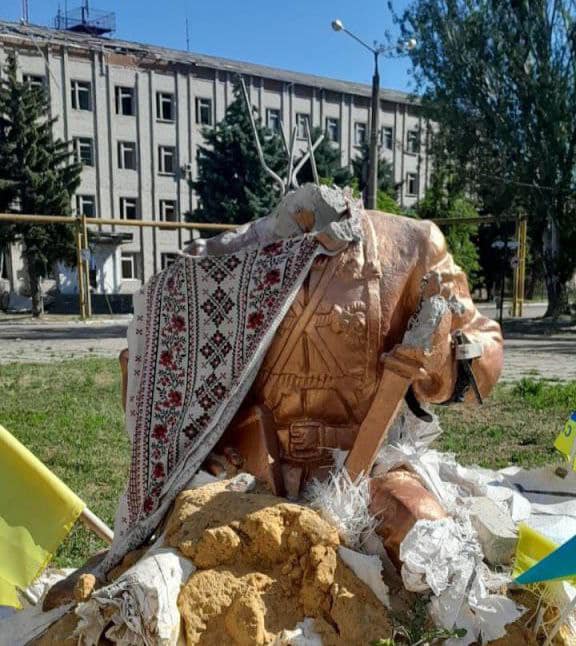Russian forces destroyed a monument to early 20th-century revolutionary Nestor Makhno in the center of Huliaipole, a town in Zaporizhzhia Oblast. Governor Ivan Fedorov reported the incident on Facebook and shared a photo of the aftermath. Although the monument was not officially recognized as a cultural heritage site, it had been an unofficial symbol of Huliaipole since 2009. This act is part of a larger pattern of destruction by the Russian military, with 46 cultural heritage sites already destroyed in Zaporizhia Oblast alone.
The destruction of the monument to Nestor Makhno is just one example of the extensive damage done to cultural heritage sites in Ukraine. As of March, at least 945 sites have been damaged or destroyed throughout the country. The famous Ukrainian revolutionary, born in Huliaipole, fought in the surrounding steppe and had his statue protected by sandbags. The monument featured a skull emblem and his signature motto “Freedom or Death.” This destruction is a stark reminder of the toll that war takes on not just human lives, but also on cultural history and identity.
According to the Ministry, Russia’s war has led to the destruction or damage of nearly 2,000 cultural facilities in Ukraine. This includes a wide range of institutions such as cultural and social clubs, libraries, art schools, museums, theaters, parks, zoos, and circuses. The loss of these facilities not only erases important historical and artistic legacies but also has a profound impact on the communities that relied on them for education, recreation, and cultural enrichment. The destruction of cultural heritage is a devastating consequence of armed conflict that cannot be underestimated.
The destruction of the monument to Nestor Makhno serves as a symbol of the broader assault on Ukrainian identity and history by Russian forces. By targeting cultural heritage sites, the invaders are not only inflicting physical damage but also attempting to erase the memory and legacy of Ukraine’s past. The destruction of these sites is a deliberate strategy to undermine the cultural resilience and national pride of the Ukrainian people. It is a violation of the fundamental human right to preserve and celebrate one’s heritage, and a cruel blow to the spirit of a nation struggling to assert its independence and sovereignty.
The Kyiv Independent has reported extensively on the ongoing destruction of cultural heritage in Ukraine, highlighting the widespread impact of the war on the country’s artistic and historical legacy. The loss of cultural facilities such as museums, libraries, and theaters represents a profound setback for the preservation and transmission of Ukraine’s cultural heritage to future generations. These sites are not just repositories of artifacts and knowledge; they are living symbols of Ukrainian identity and resilience in the face of adversity. The destruction of these sites is a tragic reminder of the human cost of war and the fragility of cultural heritage in times of conflict.
In conclusion, the destruction of the monument to Nestor Makhno in Huliaipole is a grim testament to the ongoing devastation of cultural heritage in Ukraine. The targeted destruction of these sites undermines the cultural identity and historical memory of the Ukrainian people, as well as their ability to nurture and celebrate their artistic and intellectual traditions. The loss of these sites is an irreparable blow to the country’s cultural legacy and poses a significant challenge to its efforts to rebuild and recover in the aftermath of the war. The international community must stand in solidarity with Ukraine in condemning these acts of cultural vandalism and work together to protect and preserve the world’s shared cultural heritage for future generations.


